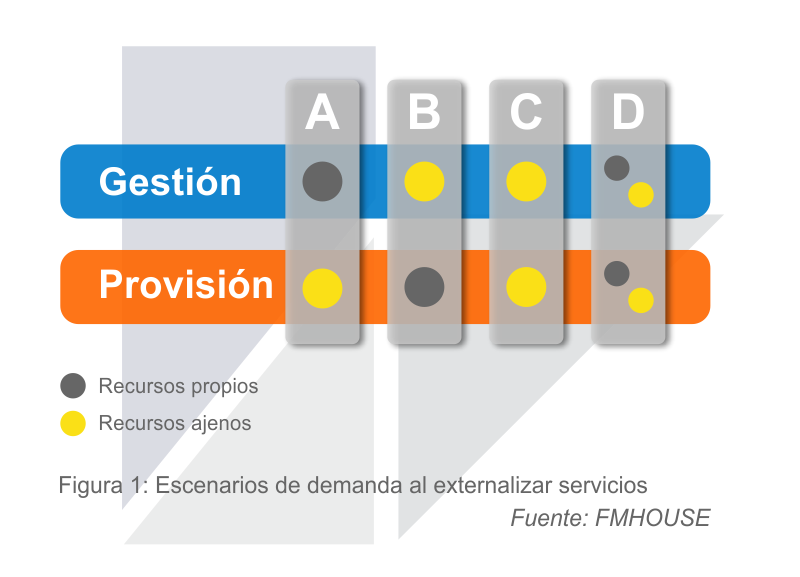This article is part of a series: (i) ‘An Introduction’, (ii) ‘Types of Demand’, (iii) ‘Types of Supply’ and (iv) ‘Win-win Relationship’ and the series is part of the content of Module number 8, “Service Provision”, of the International Master Online in FM that the FMHOUSE Institute will launch in September 2016.
With this article we want to share simple and clear information that makes it easier to distinguish in the market amongst the growing diversity of FM providers that exist, so a client can choose the proper partners and know everything necessary before inviting them to tender. It can also be useful for the supplier companies to allocate themselves in one segment or another, which can help them identify their target clients and differentiate them amongst their competitors. As we always say, without good FM providers we could not have good FM models.
It may seem difficult to identify what comes first in FM, if demand or supply in a service cycle. This difficulty lies in the fact that sometimes we as clients don’t know if we have to ask for an “FM service” or what should happen is that we should be offered that “FM service” and we as clients accept it or not. If we analyze that service cycle as a process that should be followed to defy the needs until the complete provision is achieved, it may be clear that the beginning, the trigger, must be always the definition and it should be carried out by the client without the influence of providers. What is definitely clear, and there’s no doubt about it, is that one depends and conditions the other and there must be some kind of harmony that grants the wished win-win relationship we so often preach about and defend in Facility Management.
Unfortunately, and much to our regret, in most markets not everything in FM and most companies still operate with traditional models. Mixed models start to show, models that are half way or more advanced definitions. Although a few, there are also cases where the definition of individual needs and their relation level may be considered strictly speaking 100% FM models.
Defining what an FM model is not easy and it’s not part of these articles’ scope. It’s even harder to evaluate if a model is an FM model or not and in which percentage, this is to say, how much FM it has and how much it lacks of. There are 5 basic rules that must always been fulfilled and that we will only mention to establish a common ground regarding what should be the minimum content and how this conditions demand. (i) The definition of needs should always be based on availability. (ii) The expectations of direct services and the relationships between them and all stakeholders must be fulfilled. (iii) Everything defined and proposed must be measurable with coherent metrics and criteria. (iv) A variable retribution must be linked to measurement. Finally, (v) all this as a whole must allow the highest risk transfer.
There is always a high risk if needs are not defined and coordinated under FM parameters and yet a client looks for a provider that offers this kind of service. The risk affects the client because the rules, the model, will not allow him to enjoy the expected benefits of flexibility or dynamism. The risk affects also the provider, because if he accepts the conditions without warning the client, he will find himself in unstable balance where, when the client demands what he thinks he should receive, a disagreement situation will show up, risking the contract’s continuity. And finally this risk affects also the market, which will not rely on this kind of models if both parts don’t get satisfied, when the problem was in the definition and not in FM or the providers. In this second article, we begin with the premise that when we speak about FM models all these basic and needed elements are fulfilled to articulate it successfully.
We want to focus on the possible demands types and how these condition the type of provider. To do this we will distinguish between the aspects that we already defined in the previous article about management and provision and their combinations. In a model we will always have several services and not all of them will be defined at the same level. That is to say, not all of them will be “S” and not all of them will be “SL”. Neither will we find situations where 100% of management or 100% of supply is required. There are situations where resources are shared between client and provider or providers working on the operational level or where decisions are taken together.
The analysis and decision making tasks that result in this kind of provision model, that is to say, which kind of provider we need or how many or how service should be shared or where they should be places or distributed is not part of this article and we will begin with the premise that we already have a provider model that helps us to reach the provider we’re looking for.
The models’ situations are made of the sum of the particular situations of each service and not all are always in tune. This offers a combination of situations with traditional models and situations with FM models, which makes a detailed analysis very complicated. The amount of resources that we need in each case would also be an obvious determinant, but we will not analyze that now. To simplify the multiple possible types of demand we present the following scenarios in Figure 1:
In case A, we will look for a type of provider that grants service provision from the operational point of view, being the contracting client –the company that receives the services- who makes the decisions about the type and coordination of necessary resources and the way the service is provided. Depending on how the need has been defined, if it is an “S” or an “SL”, the model will be closer to an FM contract.
In case B, what is demanded is decision making, management. We are looking for a provider that coordinates activities and resources that we assume we have in-house. Sometimes these models are used when the client exploits a building or commercial facility, although provision is also outsourced, it’s carried out by a company different form the client itself.
In case C, what we look for are external agents that provide service management and supply. In this scenario multiple combinations show up when we decide we want the same company to do everything or different companies to do it partly or just in a particular area. This, with the determining elements of the different management models, makes it necessary to carry out a detailed analysis and a deeper study.
Finally we have included a D scenario, where own and external resources are combined as much as in the management area as in the supply area. All former scenarios were “perfect”, that is to say, except for the last one all of them were all or nothing. Reality is never like that. There are always distinctive features, since all service are not equally defined, not all services enjoy the same resources, and the FM Department’s employees cannot make decisions on all the aspects they would like to.
It’s obvious that we should agree and define what we expected form every service and the combination of all services before we get out and try to hire an extern provider. Depending on the market and the types and number of existing providers we will be able to define more or less advances models, with the guaranty that we will find proper provision. This grants that we will have one or several providers that will understand what they’re asked for and will be able to offer service provision in the way we want them to. This is also decisive when we dimension the general demand.
In the next article we will continue with the types of provision, this is the FM providers’ classification.










